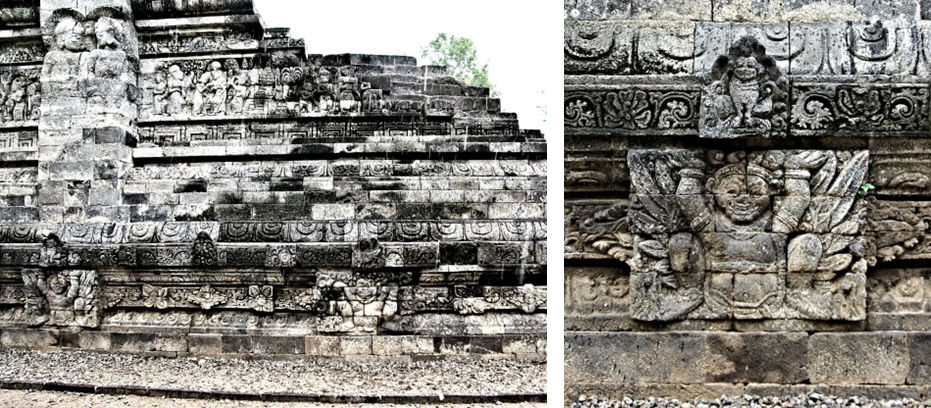
2. The Atlas that supports buildings
When I visited two candis of Majapahit period in the suburb of Kediri, I was attracted by figures which were placed at the bottom of candi’s basement, in both places, in a manner to support the upper structure, although the aim of my visit was to see the narrative reliefs.

Figures supporting the basement of Candi Tegowangi. Wide view (left) and close up (right).
Photographed by M. Iguchi, May 2009.
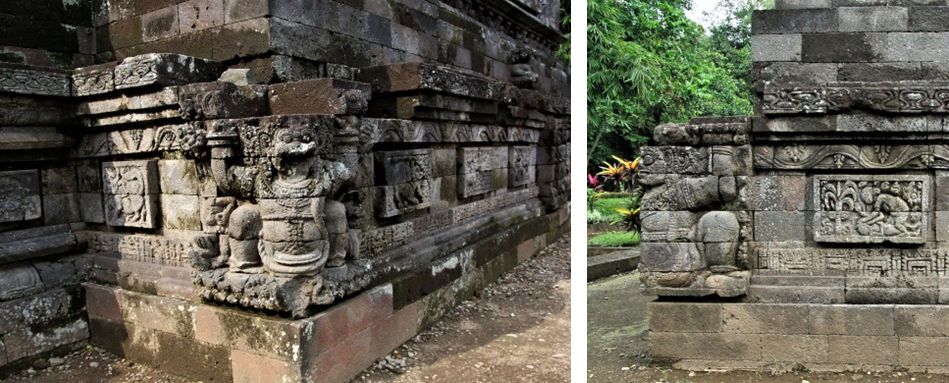
Figures at the corners of basement of Candi Surowono. Photographed by M. Iguchi, May 2009.
The figures reminded me of Atlas in the Greek mythology. Needless to say, Atlas was a Titan who challenged Olympus and was punished by the enraged Zeus to carry the globe on his shoulders or, according to Homer, to support the column that separated the heaven and the earth. Let us see the image drawn in the map collection of Mercator in the seventeenth century that derived the synonym, “atlas”, for map collections.
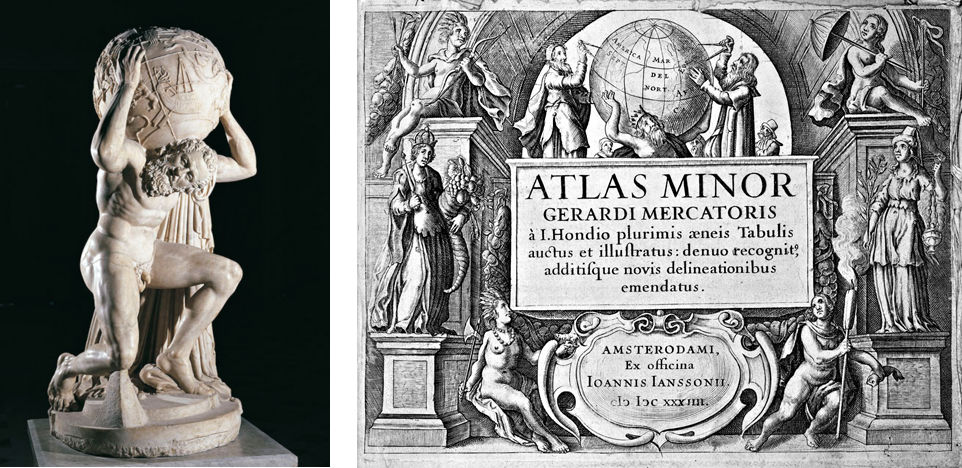
Left: The statue of Atlas (Atlante Farnese), ca. 2nd c., Marble.
The Naples National Archaeological Museum inv. 6374.
http://brunelleschi.imss.fi.it/galileopalazzostrozzi/object/FarneseAtlas.html.
Right: Atlas shouldering the globe drawn on the cover of Atlas Minor Gerardi Mercatoris. Amsterdam, Joannes Janssonius, 1634. http://www.vhu.cz/book/mercator-gerardus-atlas-minor-gerardi-mercatoris/
Later, I learnt that sculptures of Atlas supporting Buddhist buildings had existed in Gandhara.

Left: Titan Atlas, supporting a Buddhist monument, Hadda, Gandhara.
http://en.wikipedia.org/wiki/Greco-Buddhist_art
Right: Winged Atlas grey schist relief from Gandhara, 2nd-3rd century
https://www.flickr.com/photos/33255628@N00/5497032509
In above examples, the Winged Atlas may be an image of Atlas on which the same of winged-god Eros has been superimposed.
The two candis, Candi Tegowangi and Candi Surowono were built in 1358 and 1390 AD, respectively, as the mausoleum of Jayasawardhana (a brother-in-law of Rajasanegara or Hayam Wuruk) and Wijayarajasa (an uncle of Rajasanegara, died in 1388). Since the syncretism of Hinduism and Buddhism were matured in those days, it would not be unreasonable to assume that the statues of Titan Atlas adopted in the so-called Greco-Buddhism under the influence of Hellenism were imitated in these candis. The postures of Atlas in the sculptures in the two Javanese temples were the same as those in Gandhara, although their faces were different. That the figure in Candi Tegowangi had wings is also seen in the second example of Gandhara.
While I was investigating literature, I learnt the fact that figures supporting upper structures did exist also in other ancient temples. If asked why I did not notice it earlier, I must confess that I carelessly did not pay attention to the lower part of the building, having been captivated by gorgeous upper parts in candis in Kedu Basin and Prambanan Plain. For reference, both Candi Tegowangi and Candi Surowono retain only their basements, their upper structures having been entirely lost. When I visited candis in Java after then, I tried to see the sculptures in the basement as well.
Such Atlas figures may not fall in the category of “guardians” in the chapter title, as they were devised to protect the building from the convulsion of nature, rather than to protect the temple from extruders, but let me present a survey report edited in the order of the year of construction.
(2) Survey report on the Atlas figures in Candis in Java
Candi Mendut (Kedu Plain), Buddhist, ca. 782 AD
Atlas figures were found below the sculptures of Makara placed at the bottom of stringers of the staircase to the main hall. Although the faces were obscure due to the weathering, they sat cross-legged, putting their hands on their laps and supporting the upper structure on their head, as seen in the second example of Gandhara.
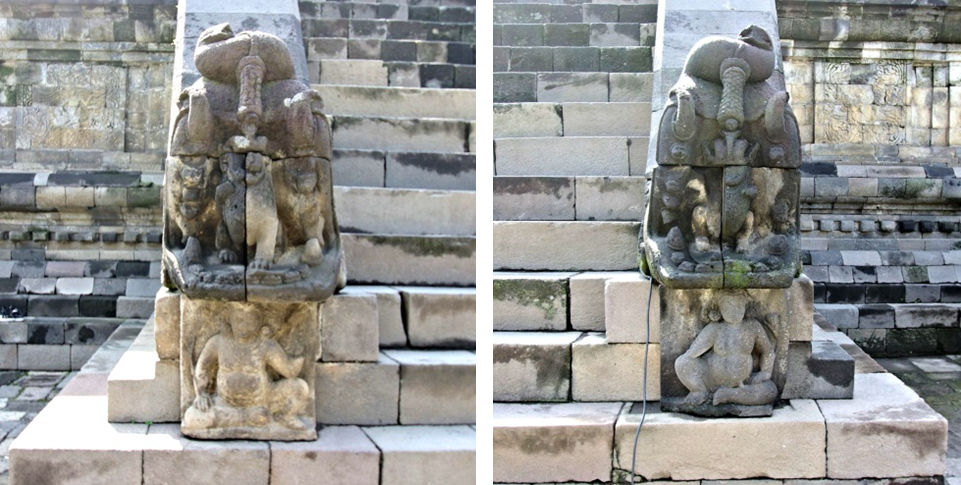
Atlas figures at the bottom of the staircase of Candi Mendut (left and right). Photographed by M. Iguchi, February 2012.
Candi Sewu (Prambanan Plain), Buddhist, ca. 780 AD
The front design of this candi’s main hall was sumptuous with many Atlas sculptures, three each underneath the Kalamakara and one each above the inner pillars of the entrance to support the lintel. Their body looked muscular and stout like that of Gandhara’s Atlas, and their posture was similar to that of weight-lifting athlete holding a barbell above his head in the first stage of snatch competition.
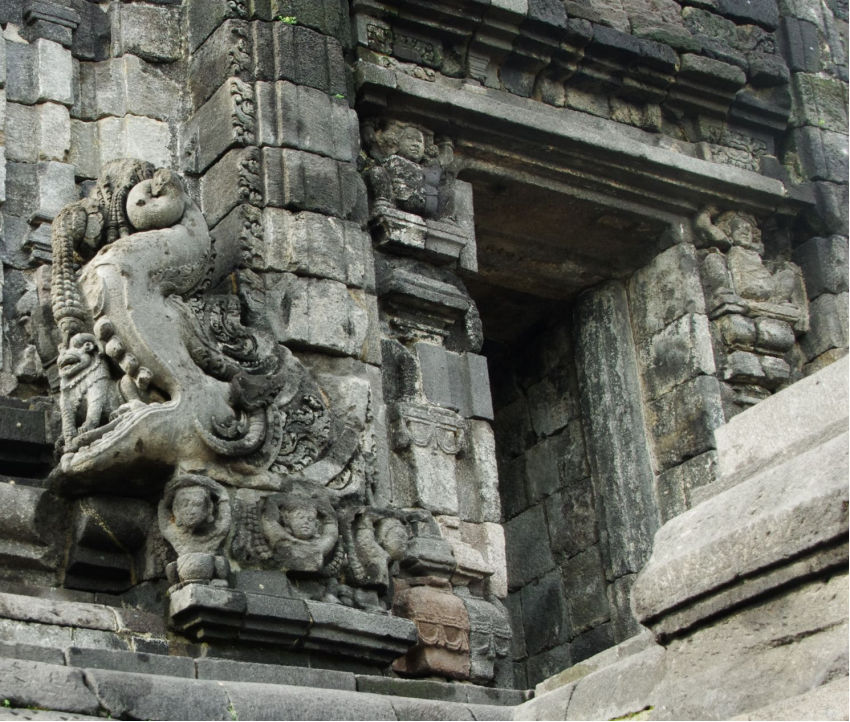
Atlas figures supporting the entrance pillars of Candi Sewu. Photographed by M. Iguchi, February 2015.
Candi Siva in Loro Jonggrang Temple Complex (Prambanan), Hindu, 856 AD
Kalamakara of Candi Siva in this main candi of Loro Jonggrang temple complex was also a sophisticated in such a way as additional Kala’s heads (lion’s heads) was placed, one each in the left- and right-hand sides, underneath the Makara of Kalamakara and between them were inserted Atlas figures were inserted between them, posing to support the kalamakara. The feature and the posture of the figures were similar to, and allegedly imitation of, those in Candi Sewu which was constructed about eighty years earlier. The state of preservation was very good, showing not only the straining face but also the hat, necklace and loincloth, keeping me for a while to see the beautiful appearance.
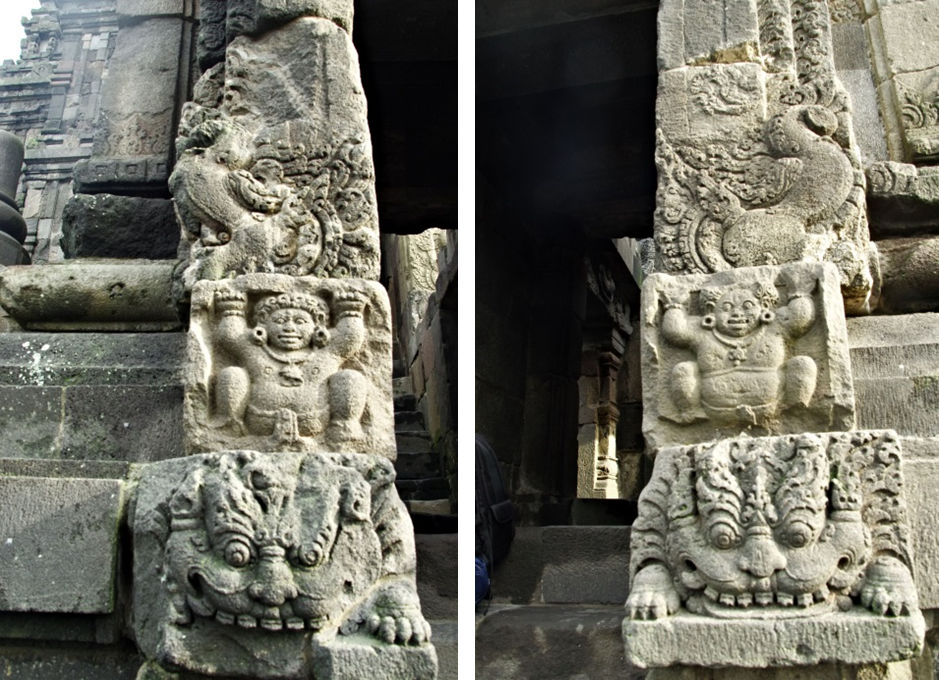
Atlas figures supporting the entrance pillars of Candi Siwa. Photographed by M. Iguchi, February 2015.
Candi Barong (Prambanan Plain South), Hindu, Late-9th c.
In this candi of a moderate size which was probably built after the Loro Jonggrang temple complex, Atlas figures were found, on the side wall of the main hall, placed in such a way to support the alcoves that were now empty. The figures were similar to those of Candi Siva but the quality of sculpturing looked inferior.

Atlas figures of Candi Barong. Photographed by M. Iguchi, February 2015.
Candi Kidal (East of Malang), Hindu, 1248 AD
In this candi constructed during the Singasari Period, more than two century after the move of the centre of kingdom from the Central Java to East Java, the figures to support the upper structure was utterly changed. At the corners of the basement were sculptures of an animal like lion, rather than of a human, and in the middle on the left, right- and rear-side walls were carvings of the divine eagle, Garuda.
The carvings of Garuda is said to represent the three scenes of the myth, called Garudeya, which was derived from Adiparwa, the introductory chapter of Mahabharata, the famous classic literature of India. A translation will be appended at the end of this section, but the story is briefly as follows.
“Among eight wives of Saint Kasyapa were Kadru and Winata. When Kasyapa asked what boon they might receive, Kadru requested one thousand snails (Nagas), whereas Kadru had wished to have two sons. They bore 1000 and 2 eggs, respectively. The 1000 eggs of Kadru hatched 500 year later and 1000 snails appeared but the two eggs of Winata showed no sign. When Winata impatiently broke one of them, a premature son, Aruna, came out and said, blaming the mother’s conduct, that “Mom will be a slave of Kadru but rescued by her another son who will be born another 500 years later from the remaining egg.” One day, Kadru invited Winata for a betting and cheated to win it to make Winata a slave. Garuda born in that situation heard that amrita (life of water) held in the heaven was necessary to rescue her mother from the hands of snakes. After a series of adventure, Garuda obtained the amrita and rescued his mother.”
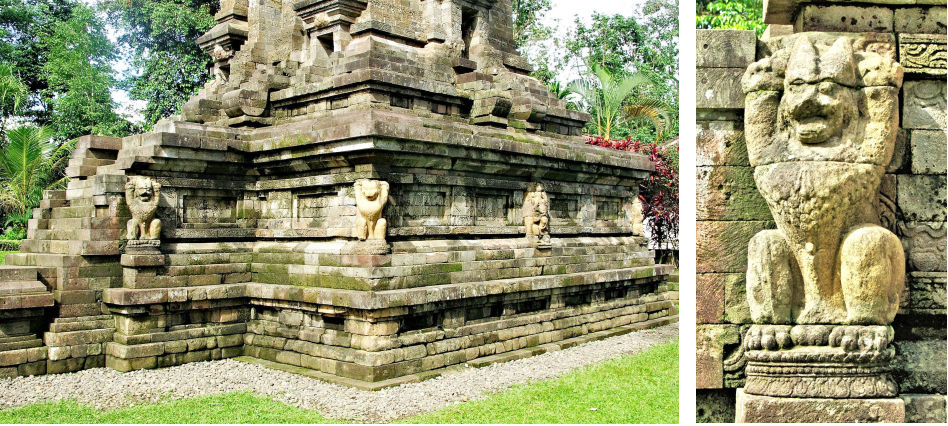
Lion figures of Candi Kidal, wide view (left) and close up (right). Photographed by M. Iguchi, February 2015.
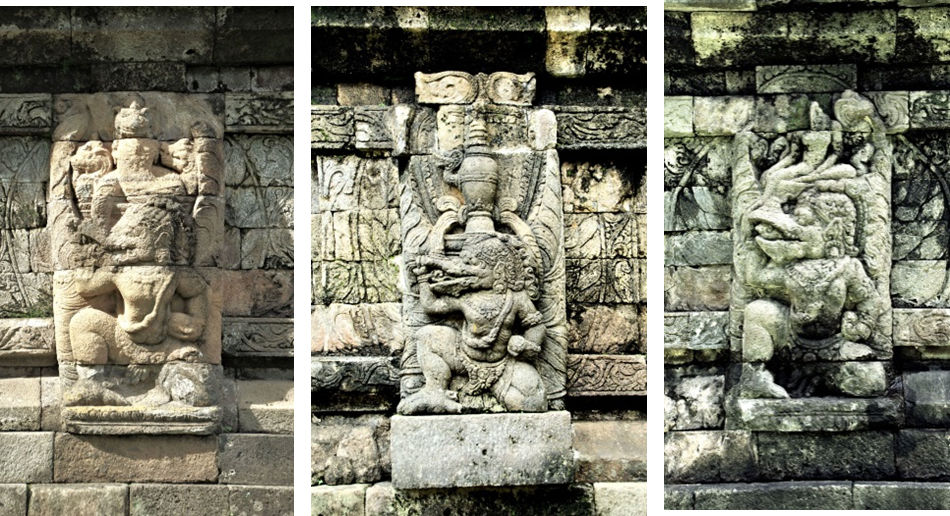
Reliefs of three scenes from Garuda Myth on the left-, right- and the rear-side walls of the basement of Candi Kidal.
Left: Garuda serving for snails, Middle: Garuda who obtained Amrita, Right: Garuda who rescued his mother. Photographed by M. Iguchi, February 2015.
In this story, Garuda was accepted to be a vehicle of Vishnu in exchange for an eternal life.
For reference, Garuda is extremely popular in Indonesia, having been adopted in the emblems of the national and the nation’s flag carrier. A statue of King Airlangga worshipped as the incarnation of Vishnu mounting on Garuda is well known. In Garuda Wisnu Kencana Cultural Park opened in Bali in 2005, huge sculptures of Garuda (head part) and Vishnu (bust) of 18 and 20 metres, respectively, are placed on the ground.
Panataran Temple Complex (North of Blitar), Hindu-Buddhism-Tantric syncretic, 14th c.
In this temple complex in the Majapahit period when the syncretism of different religions proceeded and the Java’s intrinsic culture matured, sculptures of various designs are seen.
The wall of the second floor (top floor) of the three-storeyed basement of the main temple was decorated with carvings that look-like Garuda but the animal was not an eagle but a lion with wings. At the corners of Pendopo Terrace, a flat, basement-like structure with reliefs of unidentified Panji stories on the wall, that was assumed to have been constructed as it is seen today, were found figures that also had wings. A cubic building called Candi Naga because of giant snails placed on the upper edge of side walls had statues of goddesses, that was unknown to me, at the four corners as if they were supporting the ceiling. Having seen these metamorphic figures, I had an impression that the wish to reinforce the buildings would have became of second importance and those sculptures, used as embellishments, despite that they looked to be supporting upper structures.
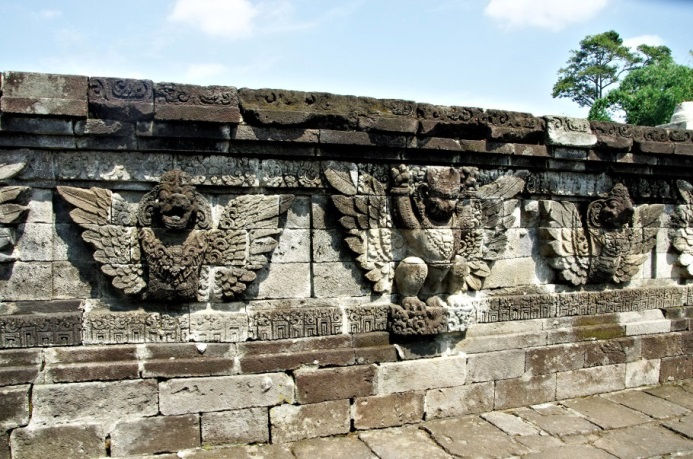
Carvings of lions with wings on the wall of the top floor of the main temple in Panataran. Photographed by M. Iguchi, February 2015.
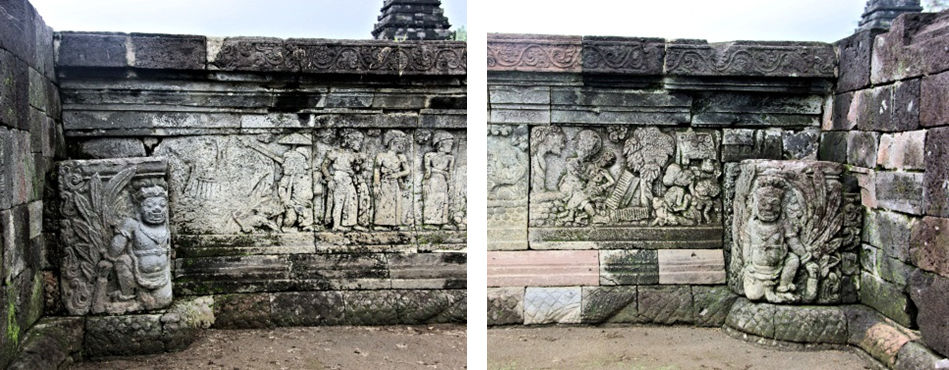
Human figures at the corners of walls of Pendopo Terrace in Panataran. Photographed by M. Iguchi, February 2015.
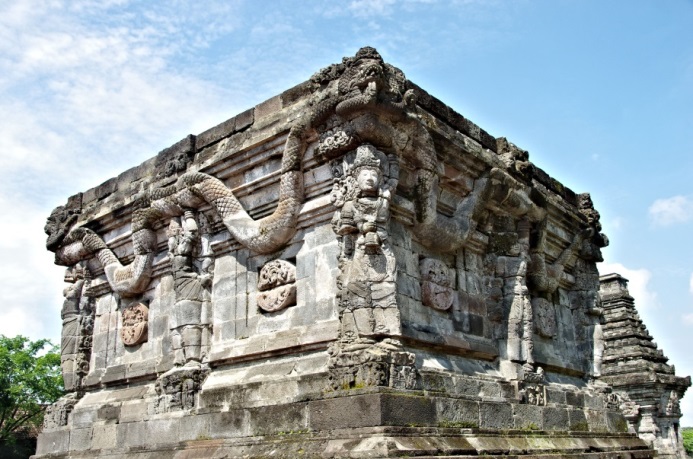
Human figures at the corners Candi Naga in Panataran. Photographed by M. Iguchi, February 2015.
(3) When Atlas was introduced into Java?
Ending my survey report on Atlas figures or figures of similar postures, a question remains to me as to when the idea to entrust the safety of buildings to Atlas was introduced in Java. In an internet article entitled “Mencicipi Keindahan Dieng, Tempat Tinggal Dewata (Appreciation of the beauty in Dieng, the abode of Gods)”[1], a photograph of an Atlas figure which resembled those in Candi Siva and Candi Barong has been found, despite I missed to see them when I visited Dieng Plateau twice more than more than fifteen years ago. No legend was added but, form to other pictures in the Internet[2], the photograph was judged to have been taken at Candi Setyaki in the Candi Gatotkaca temple complex.
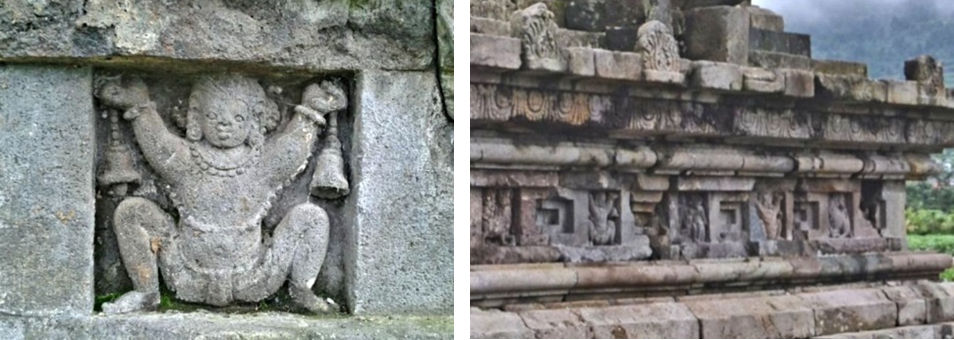
Left: An Atlas figure in “Appreciation of the beauty in Dieng, the abode of Gods”, in: http://www.life.viva.co.id/news/read/354988-mencicipi-keindahan-dieng--tempat-tinggal-dewata.
Right: A part of Candi Setyaki in Dieng Plateau. https://zanu90.wordpress.com/author/zanknoerzaman/
The construction of Hindu temples in the Gatotkaca area is assumed to have been in 650-730 AD, that was earlier than the emergence of Atlas figures in the plains of Central Java in the late 8th century when the Sailendra Kingdom arose and Buddhism prospered in the late 8th century. Thus, the possibility that Atlas figures in Candi Sewu and other were imitated in Dieng is scant. During the transfer of Hellenism to the east, the adoption of Atlas in ancient India is considered to have occurred in Gandhara area where Buddhism prospered. How the Atlas had reached Hindu temples in Dieng?
(4) Atlas sculptures in Temples within Japan
When I visited Horyuji Temple in Nata, I found carvings of animals used as vertical roof struts in the Golden Hall (main hall). One animal was lion folding his four legs and supporting the purlin of the roof on his head. Another was snail put the purlin on its head and bent neck part. The other was a personified animal that looked like a monkey or a demon, supporting the purlin with either arms or the head in a squat posture.


Animal-shaped vertical roof struts in the Golden Hall and the Five-storeyed Pagoda of Horyuji Temple, Nara. Photographed by M. Iguchi, November 2014
Top-left: Golden Hall, ground floor eaves, south-east corner, Top-right: The same, first floor eaves, south-east corner,
Bottom-left: Five-storeyed Pagoda first floor, south-east corner, The same, north-east corner.
I have not seen these kind of struts before but later learnt that the personified amimals are called “corner demons” and exist in such temples as Gansenji Temple, Kidzu, Kyoto Prefecture, and Toshoudaiji Temple, Nara, built in 729 or 749 AD and 759 AD, respectively, during the Nara Period (710-794 AD). I had a close look at them when I visited Nara and Kyoto on my next visit.
.jpg)
Layer 3
.jpg)
Layer 2
.jpg)
Layer 1
South-east North-east
Corner Demons at the Three-Storeyed Pagoda of Gansenji Temple, Kidzugawa. Corner Demons of similar designs are found also in the northwest and southwest corners, the total numbers being 12. Photographed by M. Iguchi, September 2015.
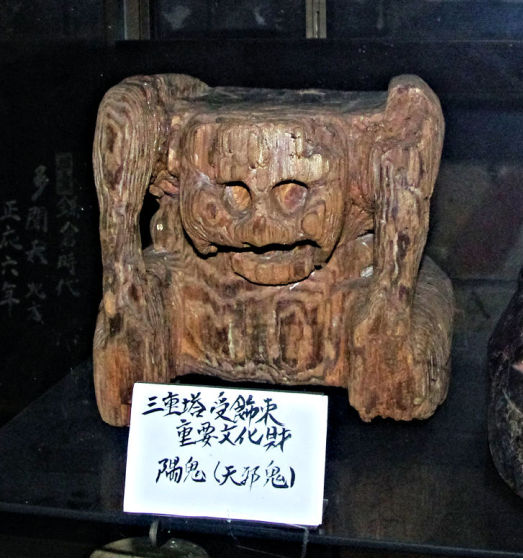
One of the original Corner Demon of Gansenji Temple,Kidzugawa, displayed in a showcase in the main hall. Photographed with special permission by M. Iguchi, September 2015.
.jpg)
North-west North-east
.jpg)
South-west South-east
Corner Demons at the Golden Hall of Toshodaiji Temple, Nara. Except for the one which was the work in the Edo Period, these Corner Demons were original one installed at the time of the temple’s construction. Photographed by M. Iguchi, September 2015.
(Close-up images taken during the restoration in 2000-2010 AD are found in the internet.)
.jpg)
North-west North-east
.jpg)
South-west South-east
Corner Demons at the Five-Storeyed Pagoda of Touji Temple, Kyoto. Photographed by M. Iguchi, September 2015.
(This pagoda was rebuilt in Kwan-ei 11 (1644 AD).
In Horyuji Temple built in the Asuka Period (572-710 AD), one finds a number of Doric columns which are considered to have been introduced through Gandhara, as pointed out by Ernest Fenollosa, an American art historian, in the late 19th century. I thought the carvings underneath the purlins must have been the imitation of Atlas but it was rather surprising that I was not able to find literature which argued such a vew.
Similar corner demons were found also above the corridor of the Founder’s Hall (Goei-do) of Nishi-Honganji Temple in Kyoto which was rebuilt in the early modern period in the 3th Year of Kwan-ei Era (1636). Although the details of the carving was not clearly seen through a protective wire net, a pair of horns was found in the photographs taken at the occasion of the Restoration of Heisei Era and shown in the temple’s website. As written as Jaki (lit. Wicked demon), the figures must have represented a sort of demons.
According to a letter received afterwards from Rev. Mitsuteruu Makino, sculptures of demon are also found in kaerumata supports (lit. frog-shaped supports) within the gable decorations of the Founder’s Hall. In photographs, they look really formidable.
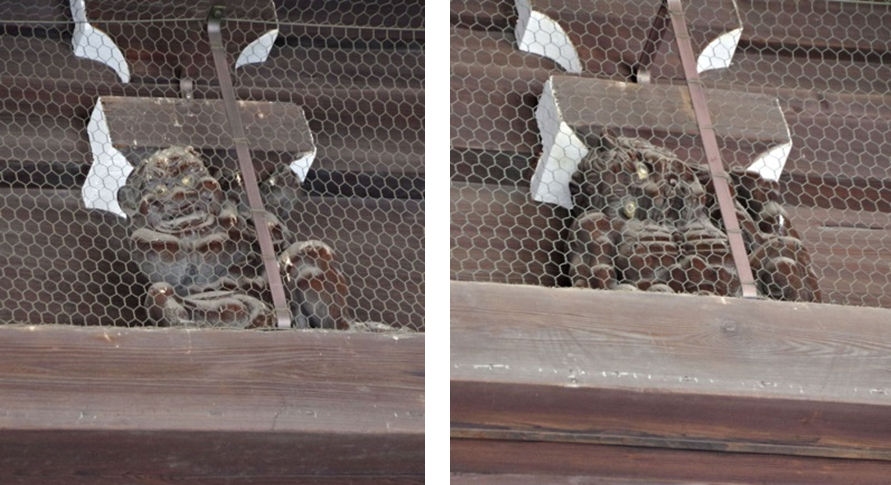
South corridor, east-end. North corridor, east -end.
Corner monsters at the Founder’s Hall (Goei-do) of Nishi-Honguanji Temple. Photographed by M. Iguchi, May 2016.
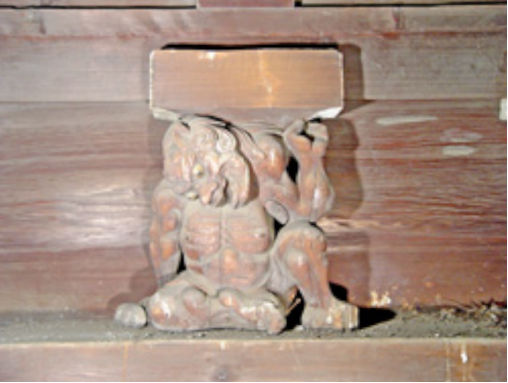
A corner monster at the Founder’s Hall (South corridor, east-end.) of Nishi-Honguanji Temple photographed on the occasion of Heisei Restoration. Duplicated from: http://www.hongwanji.or.jp/hongwanji/goei/dayori95.html
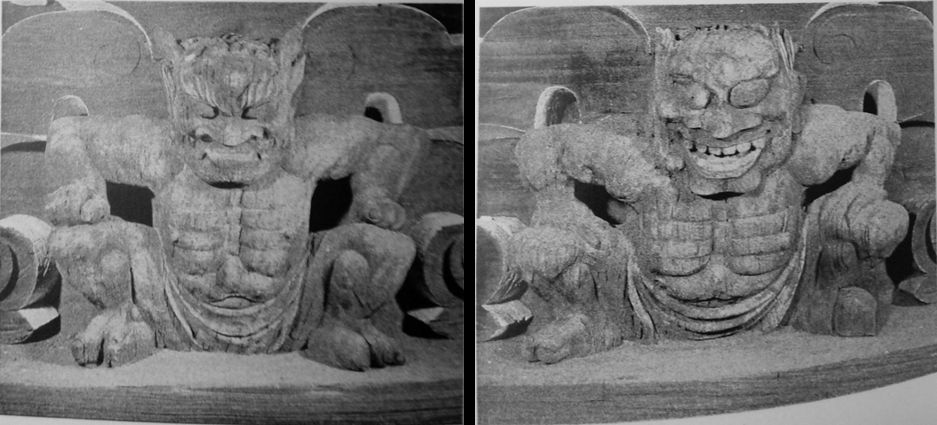
Sculptures of demon in Kaerumata supports within the decorations of the Founder’s Hall’s south gable, Nishi-HonguanjiTemple. (Left: West side, Right: East side.). By courtesy of Rev. Mitsuteruu Makino.
Besides those that support the building structure, sculptures of demon that shouldered heavy objects are found in temples in Japan. One example that I witnessed was a demon that bore the fire house of garden lantern, with his hands, head and shoulder, in the precinct of Chuzenji Temple, in Nikko. Another example was seen in front of the Sanbutsu-do Hall in Rinnouji Temple, also in Nikko, where three devils were shouldering a large insence burner in the same manner.
It was evident, however, that the garden lantern and the incense burner were not the works of old times, as letters inscribed indicated that they were dedicated in 1913 and 1961, respectively. According to the priests in the two temples, those demons were forced to bear heavy burdens for the punishment of their bad conduct, like a demon trampled down by Bishamonten (skt. Vaisravana) that were more popular, but niether of the priests had no idea whether the depiction was related to the Greek Atlas.
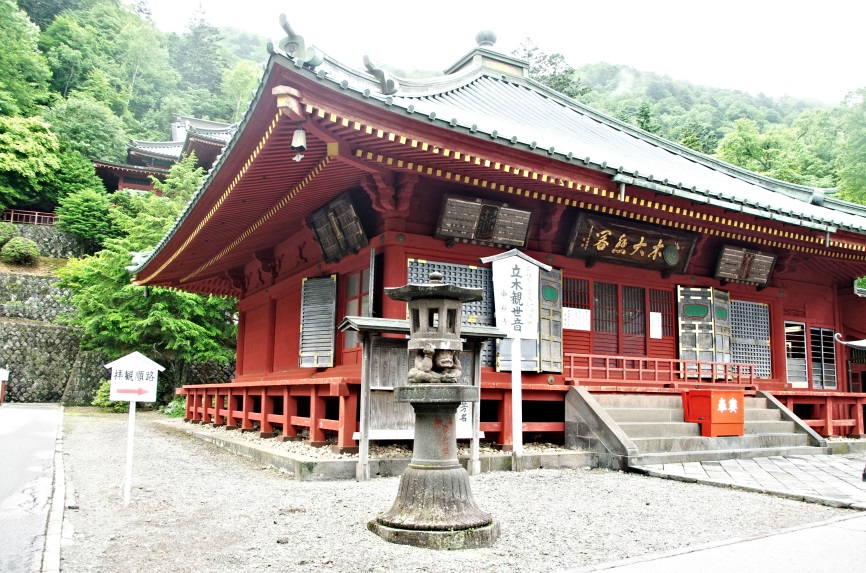
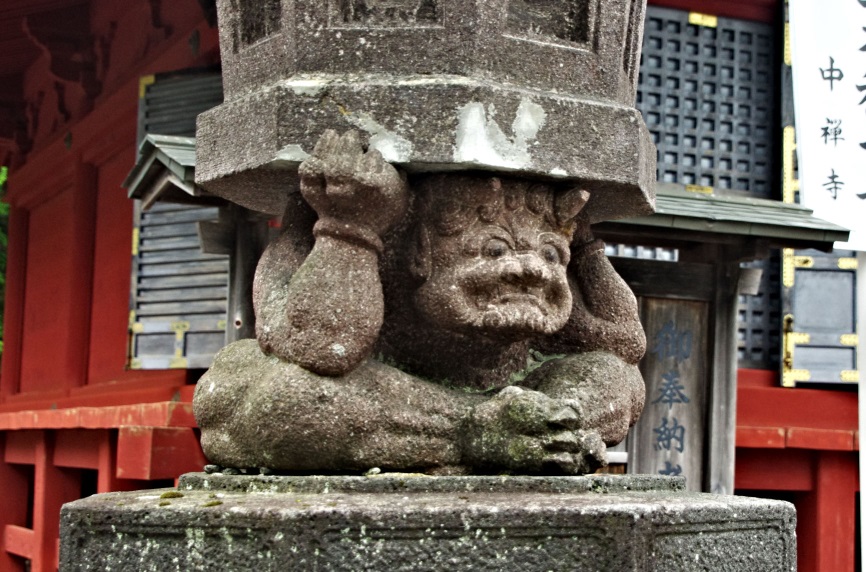
Top: A garden lantern in the precinct of Chuzenji Temple, Nikko.
Bottom: An ogre supporting the fire house.
Photographed by M. Iguchi, July 2015.
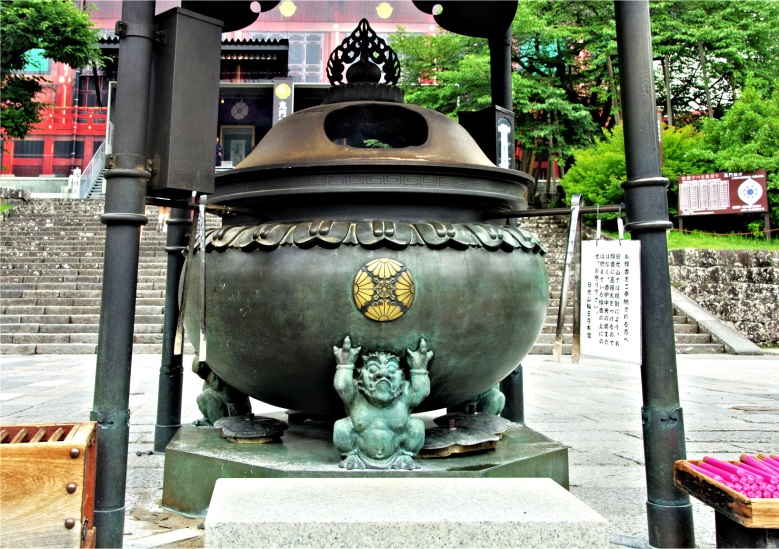
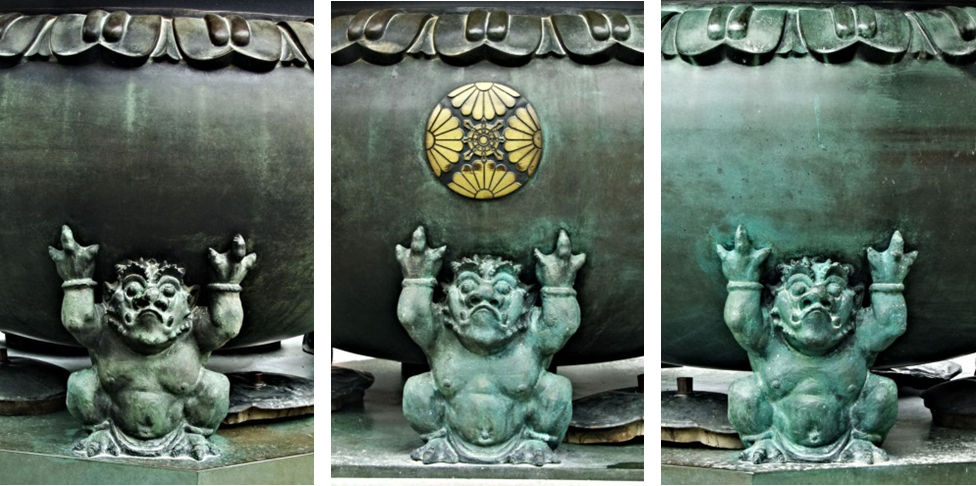
A large incense burner with three ogre feet in front of Sanbutsu-do Hall in Rinnouji Temple, Nikko.
Photographed by M. Iguchi, July 2015.
Sculptures of demons with heavy burdens seems to be found also in the incense burner in Todaiji Temple, Nara, rainwater trough in Nishi-Honguanji Temple, Kyoto, etc., although I missed to see them during my past visits to Nara and Kyoto due to the short of consciousness. As far as seen in pictures in the Internet, they also look like the works of modern times.
Below are pictures of incense burners at the Great Buddha Hall and Nigatsu-do of Todaiji Temple taken when I visited there again in a later time.
Sculptures of demons with heavy burdens seems to be found also in the incense burner in Todaiji Temple, Nara, rainwater trough in Nishi-Honguanji Temple, Kyoto, etc., although I did not notice seeing them during past visits to Nara and Kyoto. As far as seen in pictures in the Internet, they also look like the works of modern times.
Below are pictures of incense burners at the Great Buddha Hall and Nigatsu-do of Todaiji Temple taken when I visited there again on a later visit.
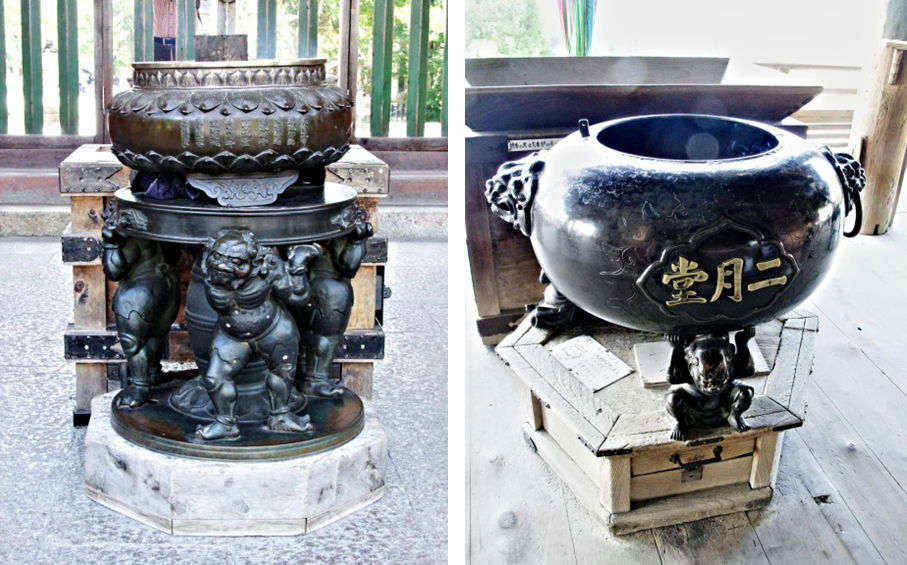
Left: Incense burner in the Middle Gate of the Great Buddha Hall of Todaiji Temple. On the side was an inscription of some sutra, 「戎香定香解脱香,光明雲臺遍法界.供養十方無量佛,見聞普薫證寂滅.延享三歳[1746]臘八月大觀進沙門公拜」, indicating that the burner was dedicated in the 3rd year of Enkyo (746 AD).
Right: Incense burner in front of Nigatsu-do of Todaiji Temple. Inscriptions of the year of donation, the 7th year of Kwansei (1795), as well as of the list of donners, were found on the side of the burner.
Photographed by M. Iguchi, September 2015.
In Nishi-Honganji Temple, there was a pair of rainwater cisterns supported by four figures at the bottom corners at the left- and right-hand sides of the entrance to the Founder’s Hall (Goei-do). According to a guide board near bye entitled Amanojaku (Ogre), the cistern had existed ever since the hall was built in the 13th Year of Kwan-ei Era (1636). Looking at the chamming figures with a bald-head and round-body which was quite different from other demons, I was amused by the humour of the unknown sculptor. I asked at the temple’s office but no details were available about these figures as well as those above the Hall’s corridor.
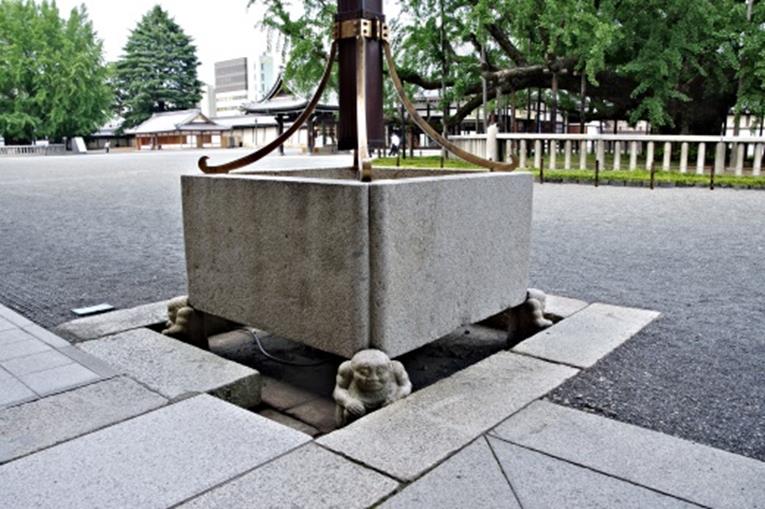

Northwest. Northeast.
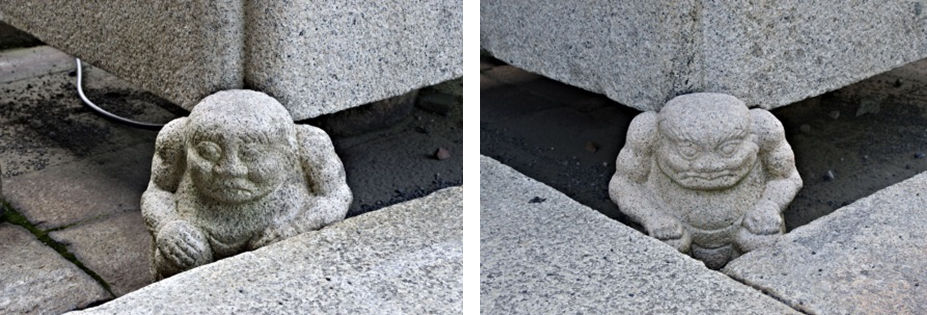
Southwest Southeast
A rainwater cistern located at the right-hand side of the entrance to the Founder’s Hall (Goei-do) of Nishi-Honguanji Temple (Top) and the four figures at the corners of the cistern.
Photographed by M. Iguchi, May 2016.
In the Edo Period, that started in the beginning of the 17th Century, corner figures depicting wrestlers or power deities which are more human-like than traditional corner monsters or ogres emerged. One place I visited was Shoshazan Engyoji Temple in Himeji in Banshu (presently in Hyogo Prefecture), often called the West Hieizan, where carvings by the hand of famous master sculptor, Jingoro Hidari, were ornamented at the Kaizan-do (Founder’s Hall) [3], inaugurated in 1671. The top of Shoshazan (Mt. Shosha, 371 m) where my friend and I climbed by a rope way was a gently‐sloping hill of approximately 200 m (north-south) x 400 m (east-west), where about a dozen temple buildings were dotted under the green shades. The Founder’s Hall was found at the depth of West Valley. The sculptures of wrestler which were sitting on the beam and supporting the angle rafter looked true to life as expected from the work of the master sculptor. The carving was detailed and the curled hair was similar to that of a European, although the face was different.
Since Jingoro Hidari was a person who had been invited by the Tokugawa Government as a master sculptor for the construction of Toshogu Temple in Nikko and who had studied the culture and styles of overseas architecture and sculptures by contacting Dutch people[4], I assume that he had a chance to see the Mercator’s Maps and used the picture of Atlas as the model of his work. I was told no detailed document existed in the Temple, however.
The Founder’s Hall was decorated also with fine relief on the front-side beam and a pair of Shishi-bana (Lion-motifed beam-end ornaments). The latter will be mentioned in “4. Lion Gatekeeper Statues”.
In a quiet place close to the Founder’s Hall was a small commemorative stone tower for a Tanka (short poem) which Lady Izumi (Izumi Shikibu), a court lady in the Heian Period, sent to Rev. Seiku, the founder of the temple. The poem sang, “Walking into the dark path from the darkness, I wish the moon on the edge of mountain will cast a light.”[5]

Left: The front view of the Founder’s Hall (Kaizan-do) of Shoshazan Engyoji Temple. Right: Southeast corner of the eave’ underside. A sculpture of wrestler and a shishi-bana are seen in the centre and centre-right areas, respectively. Photographed by M. Iguchi, June 2016.

Southeast Northeast
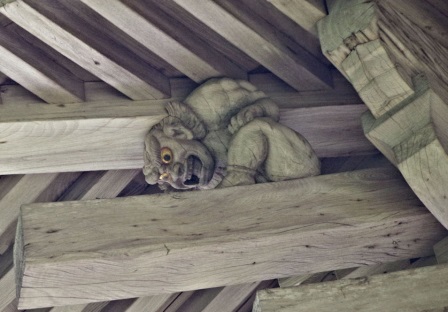
Southwest
Sculptures of wrestler at the Founder’s Hall (Kaizan-do) of Shoshazan Engyoji Temple. (The one at the northwest corner was unobsevable.) Photographed by M. Iguchi, June 2016.
Wrestler-type sculptures that are handed down as the work of Jingoro Hidari also exist at the Main Hall of Mogamisan Senshoji Temple in Midori-cho (the former Teramachi), Yamagata City. The hall is said to have been moved from Tendo in Bunroko Era (1593-96) and subsequently relocated the present place in the 3rd Year of Keicho (1598) by Lord Yoshimitsu. Four wrestler sculptures were found at the four corners crouching on the beam to support the angle rafter of the roof. Their unique design and fine carving observed through a telescopic lens convinced that they were the works of a master sculptor but their feature and posture were quite different from those of Shoshazan Engyoji Temple.
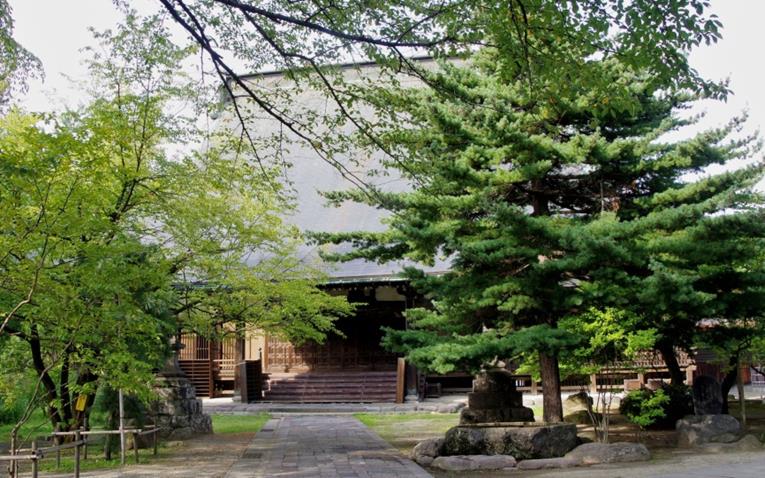
Total view.
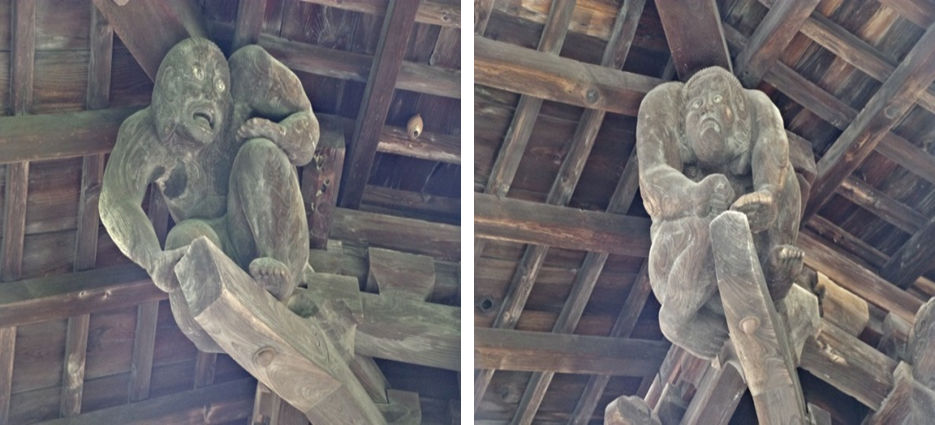
NW NE
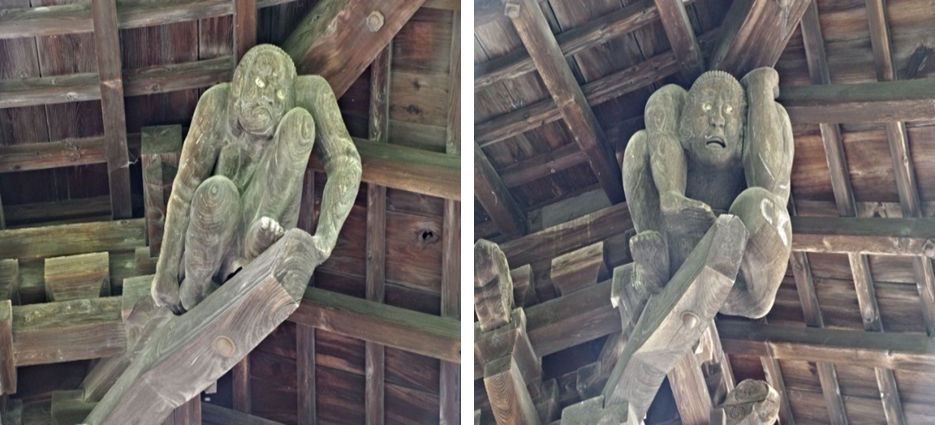
SW SE
The Main Hall and four corner wrestler sculptures of Mogamisan-Senshouji Temple, Yamagata City.
Photographed by M. Iguchi, September 2016
From the Internet I have learnt the fact that a number of wrestler-type sculptures are found In the Northeast District, especially in Akita and the northern area of Yamagata prefecture.[6], [7] I have not visited there yet but for example let me show a set of photographs taken at the Worship Hall of Hachiman Shrine in Yuwata-Kusagawa, Akita City, from an album kindly presented to me from Mr. Jubun Shibata, a local folklorist. The album included pictures taken at as many as fifty shrines and temples.


Wrestler-type sculptures at the Worship Hall of Hachiman Shrine, in Yuwata-Kusagawa, Akita City. By courtesy of Mr. Jubun Shibata.
Having researched, I have learnt that the name of the sculptors of wrestler-type sculptures in the Northeast District were unknown in most cases but the sculptures were the works in or after the Mid-Edo Period, or mid-18th Century. Since the quality of sculpturing is variable, many sculptors must have been there. I have just assumed that a certain number of good pieces were prepared by master carvers on the basis of fine sketches and that a number of their imitations spared around the respective areas.
Since Akita was the place where, Naotake Odano (1750-1780), a retainer of Kubota Clan, Lord Yoshiatsu Satake (Artist name: Shozan, 1748-1785) and others who learnt Dutch Painting from Gennai Hiraga produced a number of so-called “Akita Dutch Paintings”, it could be possible that some of them had drawn sketches of wrestlers for sculptors. Naotake Odano was a person who was invited to Edo for his sketching skill and entrusted to draw illustrations for a medical book, Kaitai Shinsho (1774), Japanese translation of the Dutch book, Ontleedkundige Tafelen, translated by Ryotaku Maeno and Genpaku Sugita. Having been close to those Dutch scholars, it would not be unreasonable to assume that he had a chance to see Atlas illustrated in the cover of Mercator’s Map Book.
Unique figures were found at the Main Hall of the Kwannonji Temple of Tendai Sect at Satsuki-cho, Nihonmatsu, Fukushima Prefecture. The chief priest who guided me around pointed out that the sculptures would have depicted not a wrestler but an imaginary creature as a tail was clearly seen in one of the pieces within the inside of the hall that was most well reserved. He told me that the main hall was formerly the Gomado Hall of Jiirokuji Temple built in the 4th Year of Genbun Era (1739 AD) at the present-day Touwa Town that was moved here in the early Meiji Era and that the sculptures were assumed to be the original ones, although the name of the sculptor and other details are unknown.
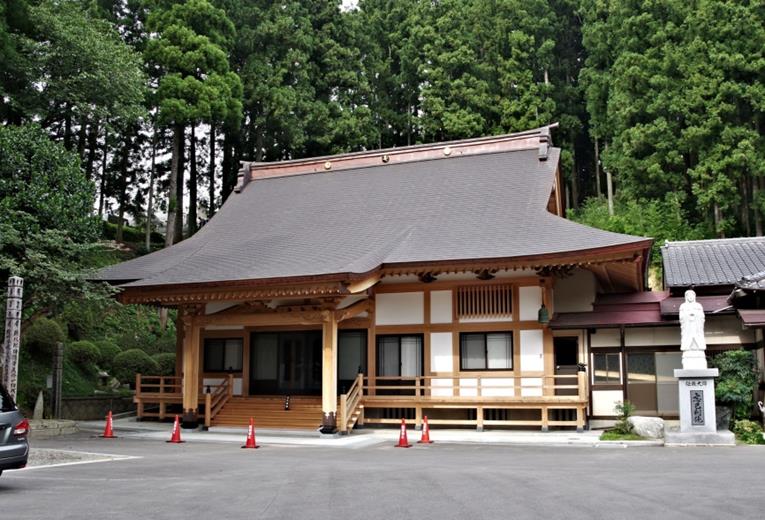
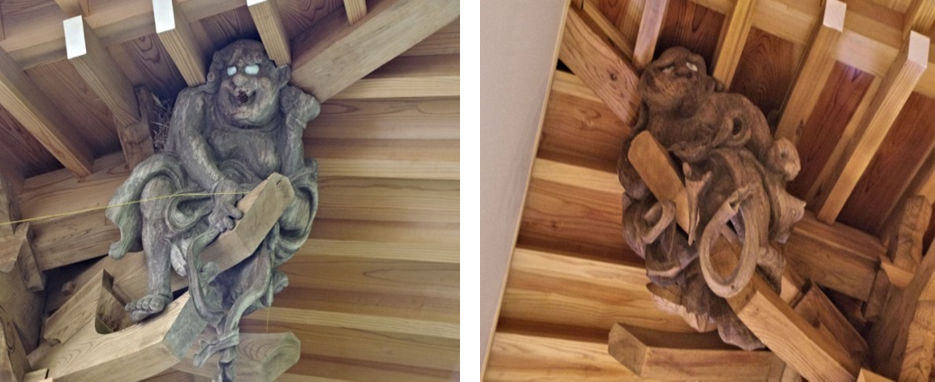
NW NE (within the hall).
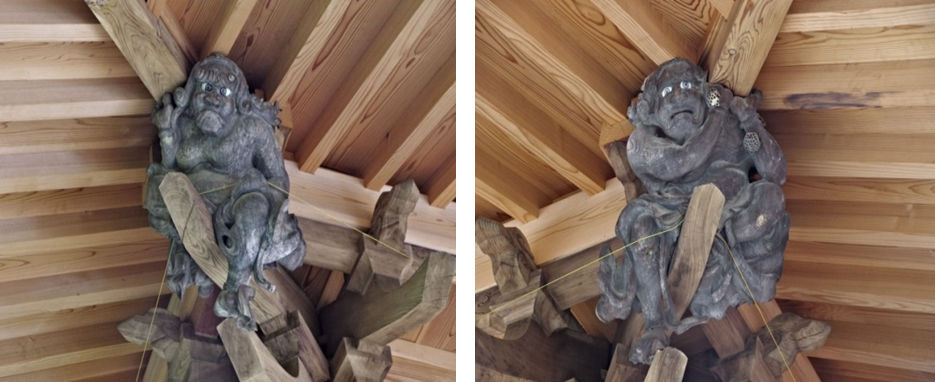
SW SE
The total view of the Main Hall and corner monster sculptures of Kwannonji Temple at Nihonmatsu, Fukushima Prefecture. Photographed by M. Iguchi, September 2016.
I have also learnt that in Awa and near-bye areas in the present-day Chiba Prefecture there are several pieces of figures sculptured in the Late-Edo Period by Ihachiro-Nobuyoshi Takeshi who is known as “Ihachi, The Carver of Waves” and whose relief is said to be the model of Hokusai Katsushika’s famous woodcut, “The Great Wave”.
Having read a conjecture that three figures on the gables of the Founder’s Hall of Nichienzan Myouhouji Temple in Horinouchi, Setagaya, Tokyo, might have been a work of Ihachi[8], I visited there. Their round body and comfortable sitting pose, however, did not look similar to the Greek Atlas or the Atlas illustrated on the Mercator’s atlas. According to the temple office, the carvings of Five Dragons on the entrance beam and three reliefs in the interior of the same hall are the works of Ihachi for sure but the carver of the figures are not known.
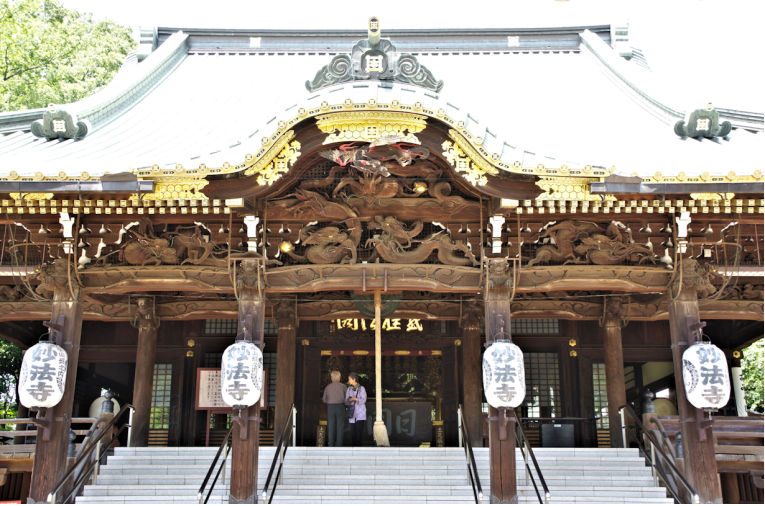
The front of the Founder’s Hall of Nichienzan Myouhouji Temple in Horinouchi, Setagaya, Tokyo, with Five Dragon Sculptures by Ihachi.
Photographed by M. Iguchi, June 2016.

East North West
Sculptures of wrestlers on the gables of the Founder’s Hall of Nichienzan Myouhouji Temple. Photographed by M. Iguchi, June 2016.
Then what are the true Ihachi’s sculpture of wrestlers like? Let me cite a picture of pieces placed on the second layer gables of the main gate to Soudoshu Saishozan Sinkoji Temple in Itabu, Ichihara, Chiba Prefecture from the temples homepage.
Although the face and muscles of the wrestlers who are enduring the weight are realistic, and accepted to be the genuine work of the master sculptor, the figures are not the kind that put one in mind of Greek Atlas and are supposed to be of Ihachi’s own design. From the date and name, i.e., “Auspicious Day, 8th Month, The year of Gold-elder/Boar-younger, The 3rd Year of Kwansei Era (1791)” and “Ihachiro-Nobuyoshi Takeshi”, written on the back of the sculptures they are know to have been sculptured when Ihachi was 40 years of age, in his prime of life.
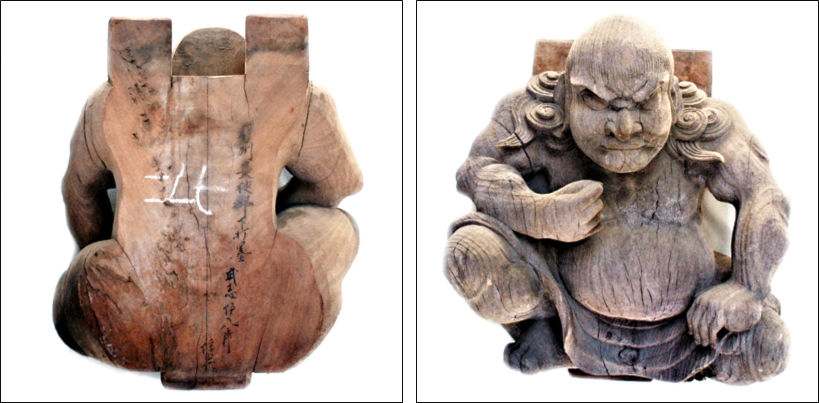
North side garble.
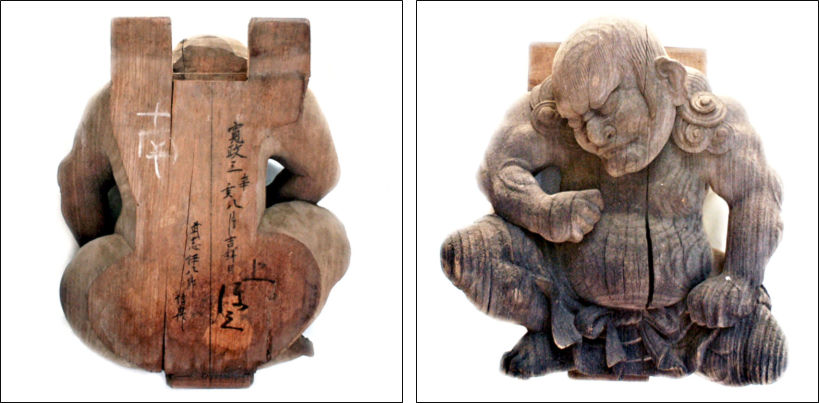
South side gable.
Sculptures of Wrestlers by Ihachiro-Nobuyoshi Takeshi at the main gate of Soudoshu Saishozan Sinkoji Temple in Itabu, Ichihara, Chiba Prefecture. Duplicated from: http://ichihara-shinkouji.jp/ihachi/
In the Haguroyama Shrine within Joshu-Kamikawachi, the presently Utsunomiya City, exist a type of sculptures of wrestlers that sit on the basement and support the upper structure of the building, the kind which were popular in Java but very rare in Japan. This shrine which in one legend is said to have been originated in the Kouhei Era (1058-65) was worshipped by the Lords of Utsunomiya in the Edo Period and the present Main Hall was rebuilt after a fire in the 13th Year of Bunsei (1830), led by a master carpenter, Hida Yamamoto, of Takanezawa, Shoya Gouri.[9] The Main Hall with which the sculptors of wrestler are found in a hollow building as if it was an internal shrine but it was not certain whether such a double structure was of original design. Since the main shrine was observable only from wired-glass windows. The upper part was not seen but the roof was supposed to be a common curved roof for shrines.
Sculptures of wrestlers were found at the southeast, northeast, northwest and southwest corners and at the middle of the east, north and west side basements, all together 7 pieces, but the state of the south side was not observable. A variety of posture of wrestlers as well as realistic curving of faces and muscles were quite impressive, implying that the sculptures were soulful works of the master carpenter or his fellow sculptor. I assumed that the idea to place the sculptures underneath the basement was theirs.
There were Shishi-bana (Lion-motifed beam-end ornaments) on the beams of Worship Hall and in the precinct was a bell tower as well as a pair of Shishi-Komainu (Lion guardian statues), proving that, before the Meiji Era, Haguroyama Shrine was a Buddhism-Shintoism syncretic entity, as actually written in literature.[10].
Haguroyama Shrine was located at the summit of Mt. Haguro (458 m) where 360-degree view is possible. Not far from the shrine stood antennas of radio relay station of Shimotsuke Newspaper Co., NHK etc.
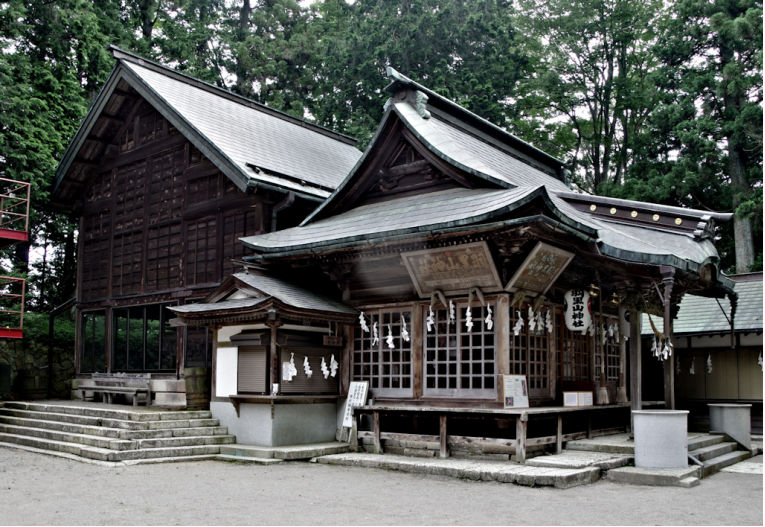
The Worship Hall (right) and the Main Shrine (left) of Kamikawahi Haguroyama Shrine. Photographed by M. Iguchi, June 2016.
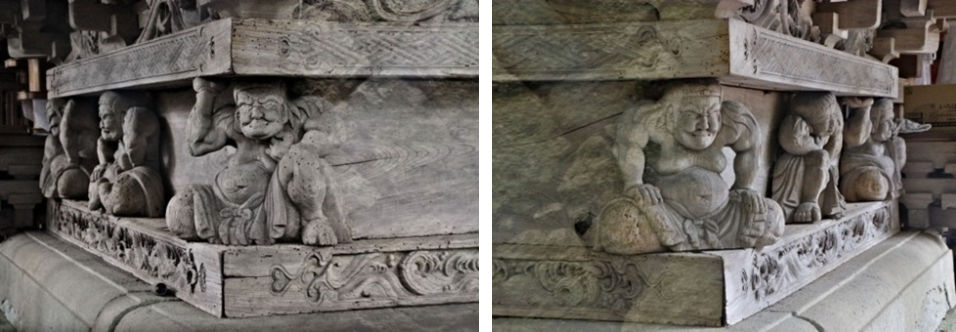
Northwest corner. Northeast corner.

North
Wrestler sculptures under the basement of Main Shrine of Kamikawahi Haguroyama Shrine. All 7 pieces. Photographed by M. Iguchi, June 2016.
Unique figures existed in the Golden Hall of an old temple, Higashi-Kouyasan Mirokuin Iouji Temple in the suburb of Kanuma City, Tochigi Prefecture, which is said to have originated as the training hall opened by Kukai, alias: Rev. Koubo, in the 4th Year of Daido (809 AD) [11],. The Golden Hall reconstructed in Houei Era (1705-07) and restored and repainted in 2012 AD was a thatched, hipped roof building, showing vivid colours, and figures were found at the four corners underneath the eave, crouching on the beam and supporting the angle rafter with their shoulders. The figures resembled neither ancient Sumioni (Corner Demons) nor early-modern wrestlers, and looked charming, but, above all, I was impressed by the fact that they were painted in different four colours, i.e., green, black, white and red, and remembered the Four Yaksha statues at the Yasha-mon (Yaksha Gate) in of Taiyuin of Rinnouji Temple, Nikko, which were also differently coloured. From the Cultural Assets Section of Kanuma City, I have received a view that the four colours is assumed to be in line with the Chinese Four Symbols, i.e., the Azure Dragon (青龍) of the East, the Vermilion Bird (朱雀) of the South, the White Tiger (白虎) of the West and the Black Turtle (玄武) of the North.[12] What did the corner figures of this temple represent, the Four Symbols or the Four Yaksha or imaginary Power Gods? Answering to this question is unable to me. The carver of these figures is assumed to be Tousuke Ishihara of Shimotsuke who was in charge of the curving of the Karamon (Chinese-style gate) of this temple, or Yahei Ishihara, his teacher. [13]

Front view of the Golden Hall
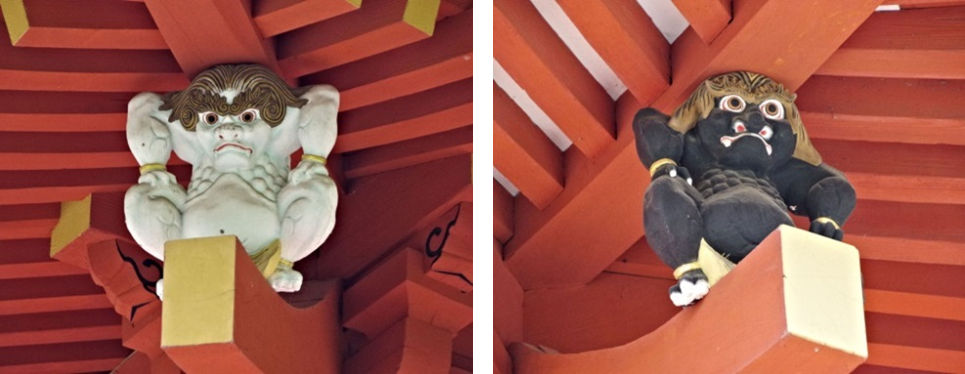
Northwest Northeast
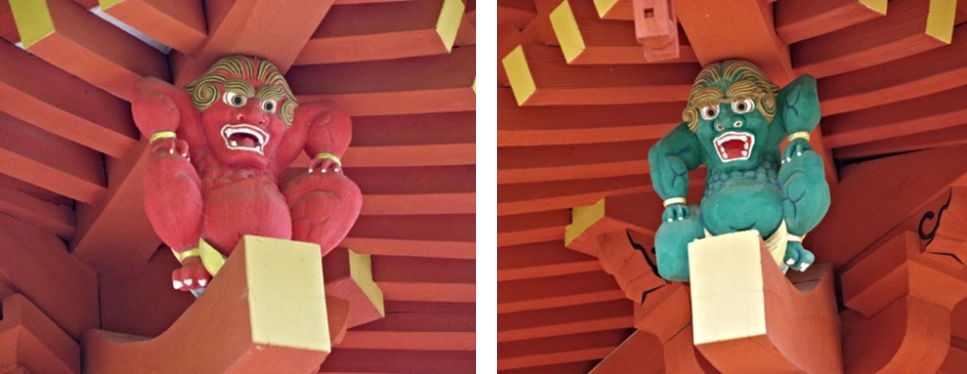
Southwest Southeast
Golden Hall of Higashi-Kouyasan Iouji Temple, Kanuma and the four corner figures.
[1]http://www.life.viva.co.id/news/read/354988-mencicipi-keindahan-dieng--tempat-tinggal-dewata.
[2] https://zanu90.wordpress.com/author/zanknoerzaman/; http://f.hatena.ne.jp/uchikoyoga/20140430%E3%82%BB%E3%83%88%E3%83%A4%E3%82%AD/
[3] Kaizan-do is said to have been founded as the mausoleum of the founder, Rev. Seiku, one year after his death in the 4th Year of Kwanko Era (1007 AD) and rebuilt in the 11th Year of Kwanbun Era(1671). https://ja.wikipedia.org/wiki/%E5%9C%93%E6%95%99%E5%AF%BA.
If the lifetime of Jongoro Hidari was 1594-1651*, the sculptures of wrestlers and others is considered to have been moved at the time of reconstruction of the hall from the old hall. *) Cf. Next endnote.
[4] 左光挙著,『名工左甚五郎の一生 』,新人物往来社 1971 ((Koukyo Hidari, The life of Jingoro Hidari, The Master Sculptor, Shin-Jinbutsuouraisha 1971).
[5] My trial translation of “暗きより暗き道にぞ入りぬべき,遙かに照らせ山の端の月”. On the board was read that the commemorative tower was dated the First Year of Tenpuku (1233), that the poem was sang in 1002- 05 AD by Lady Izuki when she desired to receive a guidance to the Buddhahood and that Rev. Seiku returned a poem, and a Buddhist’s stole. The reply poem, “日は入りて月まだ出ぬたそがれに 掲げて照らす法の灯”, meant “In the twilight after sunset prior to moonrise, I will put up a torch of the Buddha’s teaching for you” (My trial translation)...
`The years of Lady Izumi’s birth and death may be 973 and 1047 (although not certain)... (http://osaka-ikeda.blogspot.jp/2014/01/blog-post.html)。
[6] http://www.geocities.jp/akitasaisei/rikisi-gazo/riki-map.html
[7] http://blogs.yahoo.co.jp/mistral1416/36041335.html
[8] A lecture at Kakogawa Historical Museum, by Mr. Takeo Ishikawa. http://fukuchanck.exblog.jp/25464641/
[9] ibid.
[10] ibid.
[11] According to the contract record of Manyemon Nagano (carpenter), “The constriction of the Golden Hall was started in 1705 (the2nd Year of Houei Era) and finished in 1706 and the sculpturing and painting was done in 1707”. As the construction and carving was generally assigned to different persons, the carver of the carvings of the Golden Hall is assumed to be Tousuke Ichihara of Shimotsuke who was in charge of the curving of the Karamon (Chinese-style gate) of this temple, or Yahei Ishihara, his teacher. The colouring of the figures, either of Wrestlers or Power Gods is assumed to be done in line with the Four Symbols. (Abstract of a private letter from Cultural Assets Section, Kanuma City.)
[12] ibid.
[13] ibid.